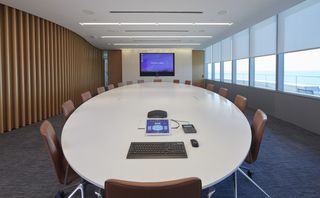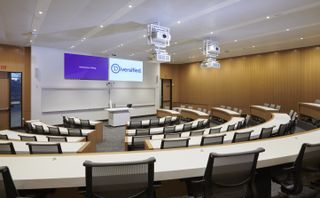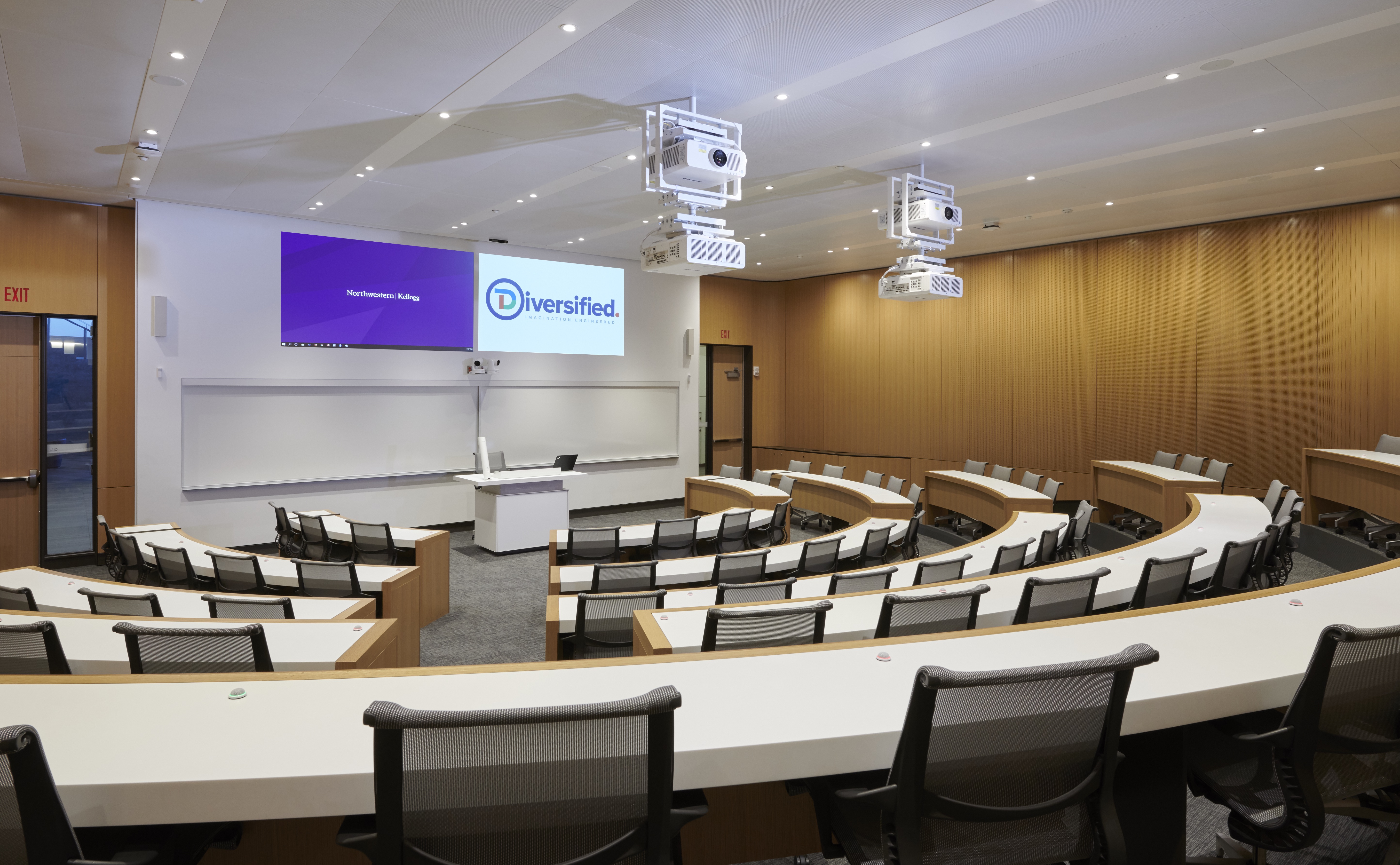With higher-education institutions reliant on broadcast video for applications like distance learning, tech managers are continually seeking out solutions that deliver significant cost savings and facilitate scalability. IP video is touted as a way to achieve this.
“[Higher ed] needs systems that are easy to deploy and low cost,” said Paul Shen, CEO at TVU Networks, a developer of IP-based live video solutions headquartered in Mountain View, CA. “You cannot just look at it as recorded content; live, impactful sessions are also becoming very important. IP gives them an opportunity because the infrastructure is already there. With a system that can fit into the existing IT infrastructure, this significantly reduces costs.”
Built on the shores of Lakes Michigan, The Kellogg School of Management’s Global Hub at Northwestern University in Evanston, IL houses collaboration spaces for both students and faculty, an auditorium, a conference center, design studios, and flexible classrooms that can be reconfigured depending on the needs of the day. More than 100 rooms are equipped with AV technology, and a centralized Evertz MMQ-10GE IP video system with a 360x360 EXE router interconnects a number of them, including 16 lecture halls, six seminar rooms, a divisible conference room, a dean’s boardroom, two large-format signage displays, a network operations center for AV, the auditorium, and a broadcast studio. Diversified, an AV and IT design and integration firm headquartered in Kenilworth, NJ, oversaw the deployment of these systems.

A custom programmed system—encompassing Evertz VistaLink Pro, Microsoft Exchange, Cisco TMS, Series 25, and Crestron Fusion—allows Kellogg’s AV team to perform resource scheduling and management. Designed to act as Cisco Immersive Telepresence rooms, two telepresence learning centers each employ three bonded Cisco SX80 codecs, edge-blended front and rear projection screens, Panasonic cameras, and tabletop boundary microphones. Other classrooms are set up much in the same way, with access to a single codec for distance learning. Dante-enabled BSS DSPs take care of audio distribution throughout the facility.
Karl Paulsen, CTO and SMPTE Fellow at Diversified, noted that Kellogg’s IP video workflow is the result of the university’s desire for less costly growth, scalability, and flexibility. “Now they’re not constrained going forward, and they have an ease of expansion,” he said. At the same time, he admits that IP broadcast environments are still in their infancy. “Now is the perfect time to start looking toward this, [but] it’s going to be five to 10 years before the lion’s share of facilities will be going in this direction.”
One of the main reasons for this is that IP video demands that traditional IT departments learn new skills. “The infrastructure becomes significantly different than it was before,” Paulsen said. “High-volume, high-bitrate networks have to be isolated.” He added that it will take some time for people to adjust to thinking differently about workflows.

“Clearly, IP is coming. The question is: what will be the right moment [for a specific organization]?” said Dave Van Hoy, president at Advanced Systems Group, an AV design and integration firm headquartered in Emeryville, CA. He said that for environments with 16 cameras or fewer, migrating to IP isn’t worthwhile because most of the signal processing technology is still based on SDI. In an IP-based workflow, this mandates converting signals into and out of IP through gateways, resulting in a considerable cost. “Why IP? If you have the budget and the time to experiment because you’re future-proofing, yes—you’re paying it forward. And if you have a large enough infrastructure where you will see an immediate ROI.”
Perimeter Institute for Theoretical Physics in Waterloo, Ontario, Canada, is gradually moving to an IP-based workflow, starting with audio first. “We [use] Dante audio over our IP network with great success, and in terms of overall production, after capturing to the NewTek Tricaster our lectures are transferred to a ProMax online server where our team can edit from their workstations with Adobe CC before publishing to YouTube or our own repository [at http://pirsa.org],” said David Fairthorne, Perimeter’s audiovisual services lead. The organization is not yet using NewTek’s NDI (Network Device Interface) for IP video, but Fairthorne and his team are conducting testing.

Fairthorne, a former video producer, explained that one of the strengths of Perimeter’s setup is that the AV and IT departments are closely aligned—in fact, they share the same workspace—which addresses the human element that plays a large role in how successful (or unsuccessful) deployments are. “The senior network admin and I are in the same office, which breeds crosspollination,” he said. The IT department uses the AV network for services like Wi-Fi, “and we use their network for transporting media and control data. We maintain it together.” He said that this streamlining saves time not only in design and deployments, but in troubleshooting as well.
While the migration to IP-based workflows is where things are headed for many organizations, getting there requires careful planning and significant effort. To set off on the right foot, Fairthorne urges higher education facilities to focus on developing solid communications between their AV and IT departments. “The very first step should be getting the IT department working closely with you—you really want to have them on board, make that connection with them, and foster a relationship where you can communicate back and forth with ease,” he said, emphasizing that his close relationship with IT at his own organization has streamlined operations for both departments. “I’ve learned a lot from IT, and they’ve learned a lot about how we’re doing things. We still raise questions with each other, but [we have an] understanding about what each team needs. Over the last seven years, it’s really worked out well for us.”
Info
ADVANCED SYSTEMS GROUP LLC
www.asgllc.com
DIVERSIFIED
www.diversifiedus.com
PERIMETER INSTITUTE FOR THEORETICAL PHYSICS
www.perimeterinstitute.ca
TVU NETWORKS
www.tvunetworks.com
AV/IT: Working Out the Wrinkles
One of the ongoing challenges with AV/IT convergence is that while IT has established standards, protocols, and policies, AV remains somewhat ad hoc. “[The AV world] is not used to the security policies and the way that IT manages their data,” said David Fairthorne, audiovisual services lead at Perimeter Institute for Theoretical Physics. “They’re used to having their own network, whereas now you’re going to have to share this network with this other system and play along with that nicely.”
IT professionals, too, need to evolve their skills in order for this to work. “Understanding the bandwidth [requirements] is a challenge,” Fairthorne said. “Enterprise environments may not have this issue, but here, the concept of doing audio over IP is fairly new, and now you have to start managing QoS [Quality of Service] and display latency, and managing it in such a way that someone checking their email isn’t getting more bandwidth than high-priority audio traveling from one room to another.”













